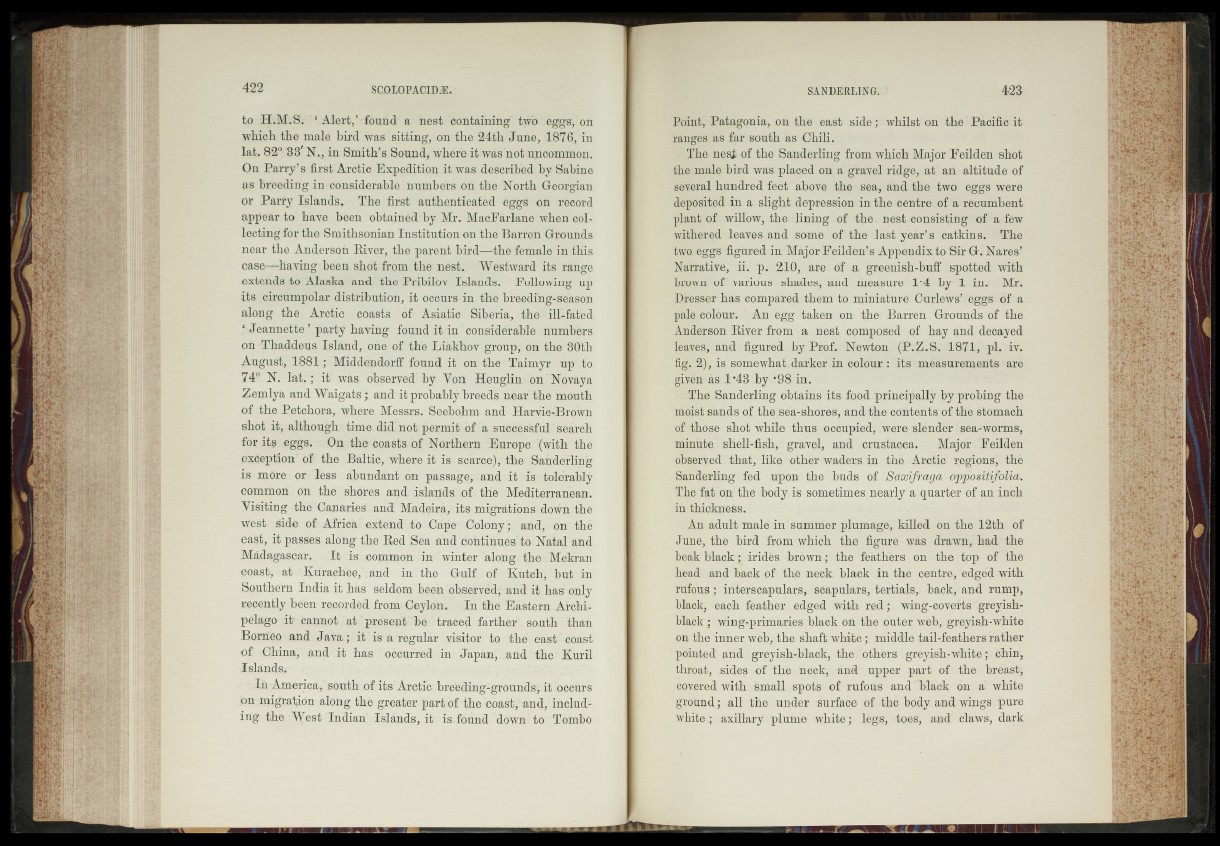
to H.M.S;' ‘/Alert,’ 'found- a best bofitaining' two eggs?ori
which the male bird was "sitting, on-the 24th June, 1876’ in
lat, 82°;^3^ N.., in Smithes Sound, where it was not uncommon.
On, Parry’s first Arctic Expedition it'was' described by Sabine
as breeding in-considerable 'numbers, on the'North Georgian
Or Parry Islands. :®re: first authenticated eggs: on record
appear to have been obtained by Mr. MacParlane whenieol-*
lecting for the Smithsonian Institution on the! Barren Grounds
near the Andersofi River, the parent birdV~the female hi this
case—having ■ been shot from the nest. - Westward its'rUiige
extends tp Alaska and' the Pribilov' Islands. " Following up
its circumpblar distribution, it occurs in the breeding-season
along the Arctic coasts of Asiatic Siberia, the ilhfated
‘ Jeannette’ party having ' found .ii ml considerable-'numbers
pn -Thaddeus lsland, one of the Liakhovgroup;; on the HOth
August, 1881; Middendorff found it on the Taimyr up "to
749 N/ l a t . ; it' was observed" b y Yon Heuglin - ion' Novaya
^epalya and Waigats ; and-itpiebaSlybreeds near'thb mouth
of the Petchora, where Messrs. ipeebohm and Harvie-lBrbiwn
Shofcit, although,'time did not permit of a successful se^reh
for its- eggs. On the coasts of Northern Europe rffwitb the
exception" of the Baltic, where itoiS seamed,-the: Sanderling
is mbre:’. ork'Jsir abundant on • passage?. and /it: iu-tolerahly
eontmoni dn thb .'.shores and islands! of the Mediterranean'.
Yisiting the CaUariesf, and! Madeira,1 its-migrations down the
.West/bide; o f Africa," extend/to Gapey'&]hh|^ and? on*?the
east, it passes along the Bed Sea'and continues" to'Natal and
Madagascar, - "It.1 is common; in "winter along- thecMekran
coast, a t rEurachee,';and' ini the ’Gulf ' of Kut&hybut. fea
Southern In.dia it has seldom been oh served^ and it has’ouly
recently.been- ^corded from;CeyIon. In the Eastern .Archipelago
i t cannot ’ atjpresefitcle'1 traced farther, south'than
Bortfcirand Java-; it "is a-Tegular "visitor, tayTheXeast^ast
pf: 43hisa>' and it has’ occurred inrJapanjXand* the-- Kuril
Islands, -
- ? pn America/ south- ofeits" Arctic breeding:grounds?it .occurs
On:teigra1po'n along the-greater parfJof The coast, and/inclnd-
ing1 the Y^jesf Indian/Islands,^ is .found sd6wn’ to- Tombo
Point/Patagonia, oni the east side ; whilst on the:'Pacific it
ranges as far. south as Chili.. -
The nest of the Sanderling from which Major Feilden shot
the male bird was placed on a’grave! ridge, at’ an altitude of
several hundred feet above the sea, and the two eggs were
deposited in a slight depression in the centre of a recumbent
plant o f willow, .the dining of- the. nest consisting of a few
withered leaves and some ' of the last ryeâr’ s catkins.' % The
twozeggs figured in Major geiMèn’s Appendix to Sir G. Nares’
Narrative, sp^P* 21.0,- are of a greenish-buff .spotted.-with
bmwn of* varidusr-shades, and measure’1*4 -by 1 in?/Mto
Bfesser has compared.them to mmiatuÉe/Cû-rlews’reggs- of-a
pale colbur/rfAbXegg ! taken on the; Barren Grounds 'df thé.
Anderson River fromwa nes.t 'composed- fgif| hay and decayed
leaves, and figured by PrcfX NewtpîL TP.Z.SÿidS^l/ pi. ivi
fig/ 2|; ip somewhat, darker in colour : its"; measurements are
given,as l -43 by-i58«in,
The Sanderling sobtains its food principally by probing the
moist sands ofthdsea-shores, and the, content s;of the stomach
of||h©se shot while thusjo.écupied?'.werefsllndbr ’sea-worms,
miniiteifeBell-fish, gravel, and .Crustacea» - Major Eeilden
observed, that,iJike^otheriwadeES,in thèyAmifiê? Regions; Thè
Sanderling fed upon ; the/huds of "Sdxifraga' opposiiifoUm
■The fat on -fheXbody,is sometimès nearly à quarter of an,inch
in, thickness, t
;'<uAn adult male inf summer plumage, killed,bn the 12th - ôf
June,fThe bird from which the figure was drawn, had, the
beak blaek^-iridéB brown* ;• * tHe feîftn|®8 ènfctbe fop of^the
head and back of, the neck black in the (ceBtre, .‘edged with
rufous; lirlfeerscapulars, scapulars, tertials?Track?-and rump,
black, each feather* edged with red? wing-covertkgreyshi-
-T&ck ; -..wing-primaries .black on the outer web? greyish-white
OKthe inner web; the' shaft white ; middle; tail-feathers father
‘ pointed’ and greyish-black, the/others, greyish-white ; chib,
throat, aides the neck;,, and‘.upper part of .-the1- breast;
covered with small/spotso of rufoiis and "black on a . white
ground ;. all ±he|5under surface of/tihè bpdy! and. wings pure
white ; axillary plume white ; legs, -Toes; and claws, dark